Science Experiments: Household Chemistry Experiments
Household Chemistry
In most homes, you already have the equipment and ingredients you need to perform some really interesting and fun household chemistry experiments! What kind of science experiments and demonstrations can you do at home? You're about to find out! Amaze your friends (or kids) with what you know about chemistry.
The experiments are:
- Vinegar Balloon
- Cabbage Juice Indicator
- Gloop
- Can Collapse
- Rubber Chicken Bones
Knowing how to do the experiments is one thing, being able to explain exactly why they happen is another. That is why each experiment or demonstration will have a list of materials (and if available links to purchase them), a procedure, and an explanation of what chemical reaction just happened. All of these experiments are suitable for homeschooling, after school, or just to show off or pass the time.
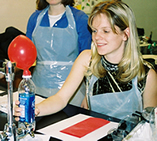
Vinegar Balloon
Materials:
- 1 Balloon
- 1 funnel
- 1 cup Baking Soda
- 1 small bottle (16 oz) vinegar
- Safety goggles (don't do like this girl -->)
Procedure:
- Take the funnel and put it in the balloon. Use the funnel to put as much of the Baking Soda in the balloon as you can. You won't use the whole 1 cup. Feel free to use it for some other purpose)
- Without getting the baking soda in the vinegar, put the balloon on the bottle of vinegar. It may be easier with less vinegar in the bottle; dump about 1/4 of the vinegar down the drain (or use it for some other purpose) if you need to
- Go outside.
- Combine the ingredients. To do this either: 1)Turn the bottle of vinegar upside down or 2) Shake the balloon so the baking soda falls out.
The balloon should blow up very big and either explode or blow off the bottle. The liquid and white stuff that may get all over the place is either baking soda residue or salt.
The reaction:
The acetic acid (vinegar) and sodium bicarbonate (baking soda) combine to make water, sodium acetate (a salt) and carbon dioxide. The carbon dioxide (CO2) is the gas that blows up the balloon and eventually causes it to burst. The reaction looks like this:
CH3COOH + NaHCO3 --> H2O + NaOCOCH3 + CO2
It is an endothermic reaction, which means that it needs heat to work, so it will feel cold in your hands.
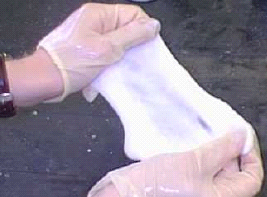
Gloop
Materials:
- 1 tsp laundry borax
- 1 tbsp white glue (ex, Elmer's Glue)
- food coloring (optional)
- two cups
- spoon
- water
Procedure:
- Dissolve the borax into 5 tbsp water in one cup. Mix until completely dissolved.
- Combine 1 tbsp glue with 1 tbsp water and food coloring (if desired). Stir until it is smooth and has a good consistency.
- Put 2 tsp borax mixture into the glue and mix.
- When mixed, the mixture will become a stiff ball. Pick it up and knead it with your hands.
The reaction:
The white glue contains a polymer dissolved in water. When the water evaporates, only the sticky polymer remains, which is why the glue holds things in place. The borate (borax + water) contains ions that allows the polymers to connect to one another in a more structured way, so that it can temporarily form a solid. Like glue, if the water in the gloop evaporates, the gloop will harden. The best way to keep it moist and flexible is to store it in a plastic bag.
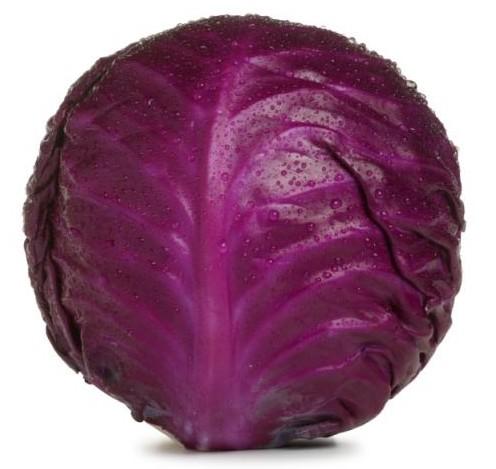
Cabbage Juice Indicator
Materials:
- Red Cabbage
- Food Processor or blender
- Strainer/fine sieve/cheesecloth
- Water
- 4 containers
- Baking Soda
- Vinegar
- Lemon or lemon juice
- Bleach
- Safety goggles
Procedure:
- Cut or tear the purplest parts of the cabbage into small pieces and put it in the blender/food processor with water. Use about equal parts water to cabbage. Run until well blended.
- Strain the liquid out of the mixture. It should be dark purple.
- Separate the Vinegar, Baking Soda (and some water), bleach, and lemon juice into into 4 containers.
- In each container put 1 tsp of each of the cabbage juice.
The reaction:
Cabbage juice is pH neutral, meaning it has a pH of 7, the same as water. It also changes color when an acid or a base is added to it. This makes it an indicator. Acids will turn the mixture pink or lavender, bases will turn it blue, green, or even yellow. See the cabbage juice pH scale.
Can Collapse
Materials:
- Empty pop can
- Tongs
- Water
- Ice
- Plastic or metal bowl
- Stove
- Safety Goggles (seeing a theme?)
Procedure:
- Put a small amount of water in the can
- Place pop can on stove until you see steam coming out the mouth.
- While the water is cooking place the ice and water in a bowl.
- When the water is boiling, use the tongs to flip the can quickly into the bowl of ice cold water.
The reaction:
The boiling of the water creates a large amount of steam within the can. This steam pushes most of the other air molecules out of the can. When the can is quickly put upside down in ice cold water, the steam in the can quickly condenses into much more dense liquid water. Since The same amount of water is taking up far less space, the pressure inside the can (which is now a closed system) rapidly decreases. The atmospheric (air) pressure outside of the can quickly crushes it.
The reason the bowl should be metal or plastic is because it is possible that the collapsing can could hit the side of a glass or ceramic bowl while it is collapsing and break it.
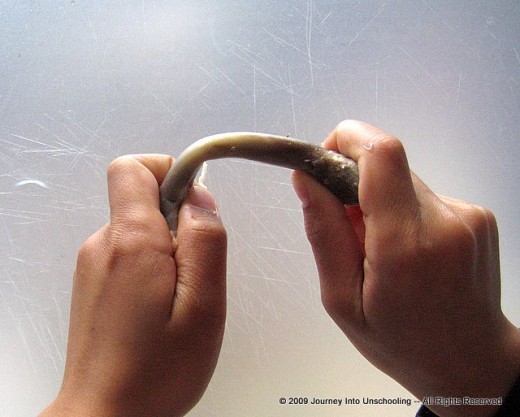
Rubber Chicken Bones
Materials:
- Chicken bones (various sizes) free of meat.
- Vinegar
- Container big enough to hold them both (preferably closable)
Procedure:
- Fill up the container with vinegar.
- Put in the chicken bones and close the container.
- Wait 2-3 days.
The reaction:
Bones contain something called "calcium carbonate". This is what makes them hard. It is a base.
Vinegar, as we said before, is an acid known as acetic acid.
When calcium carbonate (the bone) and acetic acid (the vinegar) combine, a chemical reaction takes place and carbon dioxide (a gas) is released. This is what the bubbles are made of.
Vinegar + Calcium Carbonate --> Water + Carbon Dioxide + Calcium Acetate
2 C2H4O2 + CaCO3 --> H2O + CO2 + CaC4H6O4
The chemical reaction keeps happening until all of the carbon in the bone is used up - the time it takes varies depending on the size of the bone.
When you take the bone out of the vinegar it's soft because much of the calcium and carbon in the calcium carbonate left each other. The carbon floated out of the bone in those little bubbles. The calcium was dissolved into the vinegar to become calcium acetate.
After you take the bone out of the vinegar, the bone re-absorbs carbon from the air (carbon dioxide), the reaction will reverse, and the bone hardens in its new shape.
Related Links
- Types of Chemical Reactions
by Dosters
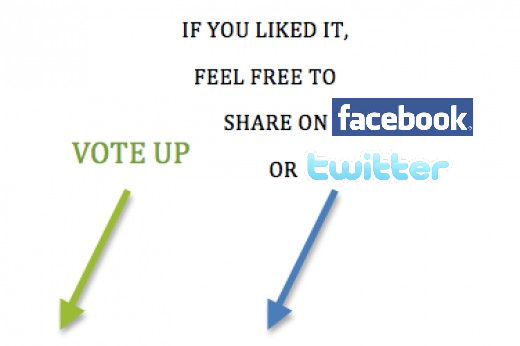
Additional Experiment links and hubs
- Easy Snow and Ice Experiments
Ideas for simple but cool science experiments about snow and ice that will get kids interested in learning about nature's frozen wonders. Includes exploding ice, making frost, snow, and icicles, salt, and dry ice. - Fizzles, Explosions, and Eruptions: Simple Science Experiments Gone Mad
Erupting volcanoes and bubbling test tubes are fun to watch and more fun to make. Creating strange mad scientist concoctions is simpler than you may think using stuff already in the kitchen.





